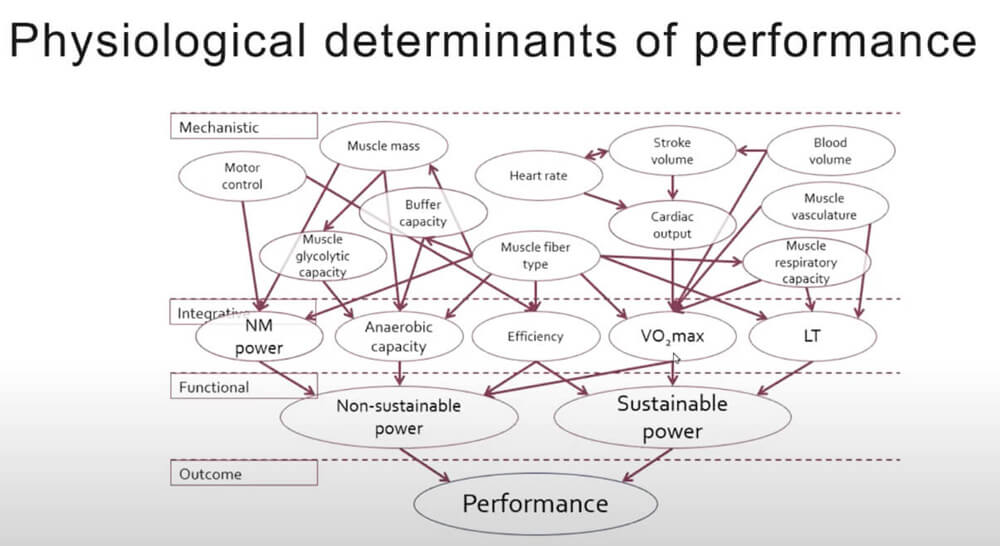Why are your sports results what they are?
Performance factors
Tim Cusick is one of my go-to coaches and thanks to him, many coaches have followed in his wake to be able to better understand how the human body works in terms of performance.
In a webinar of his that I attended, he shared with everyone virtually present a graph through which, schematically, one could perfectly see each and every one of the performance factors that explained why each person obtains some sports results.
It is certainly very clarifying since it gives you a global idea of the combination of things necessary to obtain a certain sporting performance and, therefore, you can get to know what to improve with training.
The graphic in question property of Dr. Tim Cusick.
In making the graph, Cusick organizes it according to 4 different levels. If you imagine a cake and starting from the bottom up, the yield would be the cake on top. That is, what is seen, what comes out (outcome in English).
Below this level, we find the level of functionality, in this case, whether the effort is sustainable or not. In other words, if it is an aerobic or anaerobic effort, respectively.
If we continue dissecting and increasing the level of concretion, we find ourselves with a lower level in which the most basic factors are integrated. At this integrative level we find efficiency, which is a common condition of sustainable efforts but also of unsustainable ones.
Apart from efficiency, the neuromuscular mechanisms of power and anaerobic capacity are the determinants of the performance of non-sustainable efforts, while the maximum oxygen consumption and the anaerobic threshold are those of sustainable efforts.
At this point, it is when we find ourselves with the greatest complexity since going down to the most basic level, the one that makes up the cake at the bottom of the cake, taking advantage of the previous metaphor, we find many conditioning factors that are interrelated. Going into detail we have:
For non-sustainable anaerobic efforts
At the center of it all, the type of muscle fiber
Genetic conditions and training will determine the type of muscle mass and respiratory and lactate recycling capacity that you have.
This will mean at a higher level that it is the main determinant of neuromuscular power (if an individual has many fast twitches); what anaerobic capacity supports (if an individual is able to support large amounts of lactate or recycle it quickly); the level of efficiency (if coordinatively it has a great performance capacity); maximal oxygen consumption and anaerobic threshold (if an individual has large numbers of mitochondria in muscle cells).
At the extreme of anaerobic work, motor control
This will determine the degree of neuromuscular power as well as the efficiency of the movement. To train it, it is a matter of working intra and intermuscular coordination and obviously the technique of our sports discipline.
Muscle mass as the basic structure
As I mentioned above, this is determined by the type of muscle fiber and determines the ability to break down energy and convert it into movement. Therefore, it determines the maximum brute force capacity as well as the anaerobic capacity.
The anaerobic energy system, glycolytic capacity and lactate recycling
And it is that without the supply of energy we could not do anything even having the best system of muscle fibers or great coordination. Thanks to the glycolytic capacity of the muscle and the ability to reuse the lactate that is generated as a residue of anaerobic glycolysis.
For sustainable aerobic efforts
An interconnected system based on the cardiocirculatory system
Where the heart rate, the volume of blood ejected by the heart in each beat and the total volume of blood, condition the maximum oxygen consumption. That is, the maximum aerobic power of the engine of each athlete.
The respiratory capacity of the muscle
Based on the degree of vascularization of the same (the number of blood vessels with which oxygen is nourished and CO2 discarded) as well as the degree of structures that are capable of taking advantage of that oxygen to transform it after fuel degradation into mechanical energy.
Thanks to all this, the maximum oxygen consumption will be determined again but also the anaerobic threshold.

